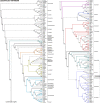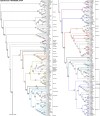Towards a phylogenetic classification of Leptothecata (Cnidaria, Hydrozoa)
- PMID: 26821567
- PMCID: PMC4731775
- DOI: 10.1038/srep18075
Towards a phylogenetic classification of Leptothecata (Cnidaria, Hydrozoa)
Abstract
Leptothecata are hydrozoans whose hydranths are covered by perisarc and gonophores and whose medusae bear gonads on their radial canals. They develop complex polypoid colonies and exhibit considerable morphological variation among species with respect to growth, defensive structures and mode of development. For instance, several lineages within this order have lost the medusa stage. Depending on the author, traditional taxonomy in hydrozoans may be either polyp- or medusa-oriented. Therefore, the absence of the latter stage in some lineages may lead to very different classification schemes. Molecular data have proved useful in elucidating this taxonomic challenge. We analyzed a super matrix of new and published rRNA gene sequences (16S, 18S and 28S), employing newly proposed methods to measure branch support and improve phylogenetic signal. Our analysis recovered new clades not recognized by traditional taxonomy and corroborated some recently proposed taxa. We offer a thorough taxonomic revision of the Leptothecata, erecting new orders, suborders, infraorders and families. We also discuss the origination and diversification dynamics of the group from a macroevolutionary perspective.
Figures




Similar articles
-
Hydroids (Cnidaria, Hydrozoa) from Mauritanian Coral Mounds.Zootaxa. 2020 Nov 16;4878(3):zootaxa.4878.3.2. doi: 10.11646/zootaxa.4878.3.2. Zootaxa. 2020. PMID: 33311142
-
Phylogenetic relationships of Proboscoida Broch, 1910 (Cnidaria, Hydrozoa): Are traditional morphological diagnostic characters relevant for the delimitation of lineages at the species, genus, and family levels?Mol Phylogenet Evol. 2017 Jan;106:118-135. doi: 10.1016/j.ympev.2016.09.012. Epub 2016 Sep 14. Mol Phylogenet Evol. 2017. PMID: 27639479
-
Molecular phylogenetics of Thecata (Hydrozoa, Cnidaria) reveals long-term maintenance of life history traits despite high frequency of recent character changes.Syst Biol. 2009 Oct;58(5):509-26. doi: 10.1093/sysbio/syp044. Epub 2009 Aug 21. Syst Biol. 2009. PMID: 20525605
-
The evolution and development of coloniality in hydrozoans.J Exp Zool B Mol Dev Evol. 2021 Apr;336(3):293-299. doi: 10.1002/jez.b.22996. Epub 2020 Aug 15. J Exp Zool B Mol Dev Evol. 2021. PMID: 32798274 Review.
-
Biology and ecology of the hydrocoral millepora on coral reefs.Adv Mar Biol. 2006;50:1-55. doi: 10.1016/S0065-2881(05)50001-4. Adv Mar Biol. 2006. PMID: 16782450 Review.
Cited by
-
New Insights into the Biodiversity of Benthic Hydroids (Cnidaria, Hydrozoa) from Seamounts in the Remote Macquarie Ridge, with the Description of Three New Species.Zool Stud. 2024 Jun 20;62:e17. doi: 10.6620/ZS.2024.63-17. eCollection 2024. Zool Stud. 2024. PMID: 39659812 Free PMC article.
-
First records of hydroid epibionts on the introduced macroalga Gracilariaparvispora in the Mexican Pacific.Biodivers Data J. 2024 Sep 11;12:e130248. doi: 10.3897/BDJ.12.e130248. eCollection 2024. Biodivers Data J. 2024. PMID: 39301512 Free PMC article.
-
Hundreds of genetic barcodes of the species-rich hydroid superfamily Plumularioidea (Cnidaria, Medusozoa) provide a guide toward more reliable taxonomy.Sci Rep. 2018 Dec 20;8(1):17986. doi: 10.1038/s41598-018-35528-8. Sci Rep. 2018. PMID: 30573739 Free PMC article.
-
Reproductive and environmental traits explain the variation in egg size among Medusozoa (Cnidaria).Proc Biol Sci. 2023 Aug 9;290(2004):20230543. doi: 10.1098/rspb.2023.0543. Epub 2023 Aug 2. Proc Biol Sci. 2023. PMID: 37528708 Free PMC article. Review.
-
Community Composition of Epibiont Hydroids of the Naturalized Alien Macroalga Acanthophora spicifera in Pichilingue, Mexico.Biology (Basel). 2025 Jan 8;14(1):44. doi: 10.3390/biology14010044. Biology (Basel). 2025. PMID: 39857275 Free PMC article.
References
-
- Daly M. et al. The phylum Cnidaria: A review of phylogenetic patterns and diversity 300 years after Linnaeus. Zootaxa 1668, 127–182 (2007).
-
- Schuchert P. Hydrozoa in World Register of Marine Species (2014). Available at: http://www.marinespecies.org/aphia.php?p=taxdetails&id=1337. (Accessed: 24/03/2015).
-
- Schuchert P. World Hydrozoa Database (2014). Available at: http://www.marinespecies.org/hydrozoa. (Accessed: 24/03/2015).
-
- Cornelius P. F. S. North-West European thecate hydroids and their medusae: part 1 introduction, Laodiceidae to Haleciidae: keys and notes for identification of the species. Synopses of the British Fauna -New Series- No.50 [Barnes R. S. K., Crothers J. H. (ed.)] [347 pp.] (Field Studies Council, Shrewsbury, 1995).
-
- Cornelius P. F. S. North-West European thecate hydroids and their medusae: part 2 Sertulariidae to Campanulariidae: keys and notes for identification of the species. Synopses of the British Fauna -New Series- No.50 [Barnes R. S. K., Crothers J. H. (ed.)] [386 pp.] (Field Studies Council, Shrewsbury, 1995).
Publication types
MeSH terms
LinkOut - more resources
Full Text Sources
Other Literature Sources
Molecular Biology Databases

